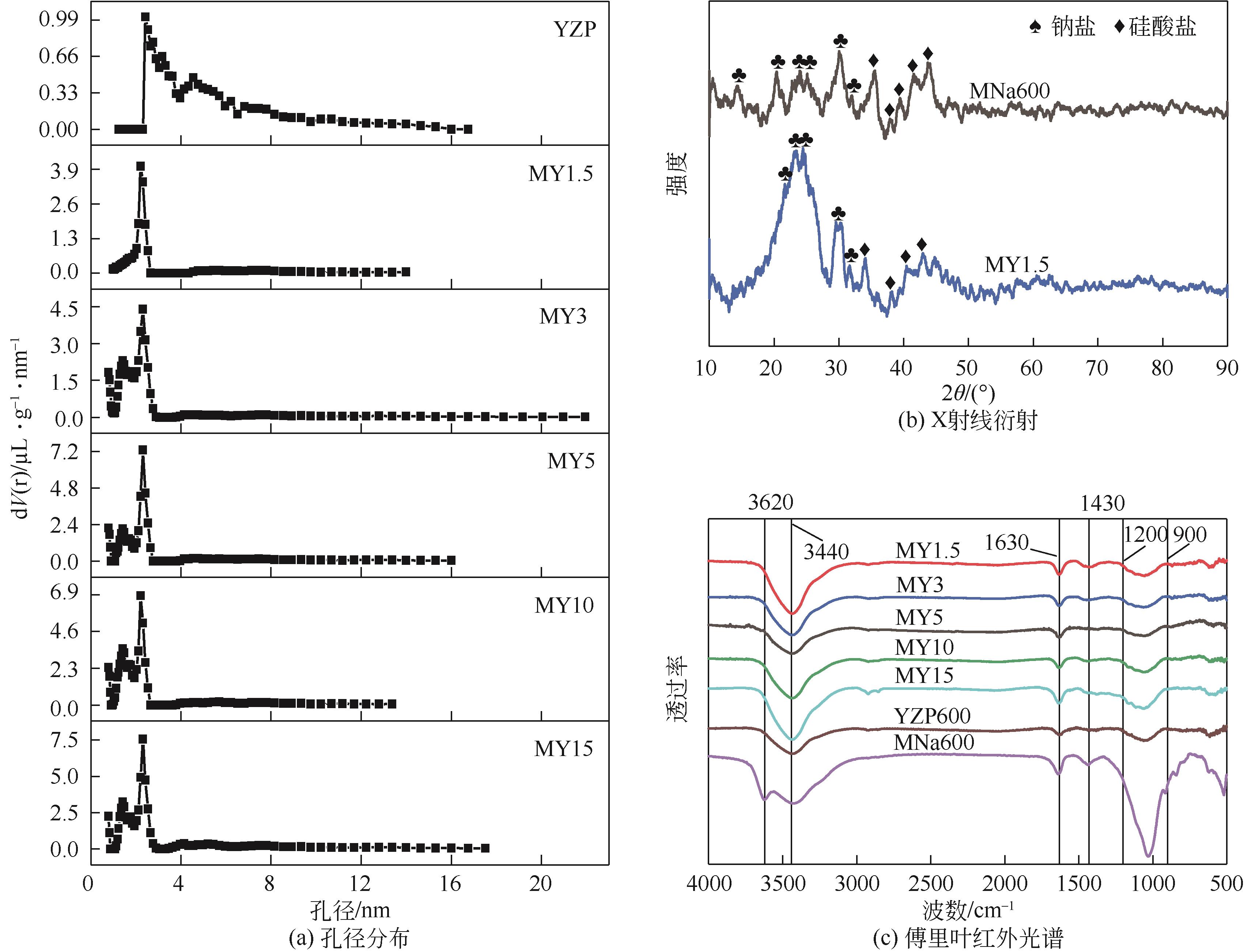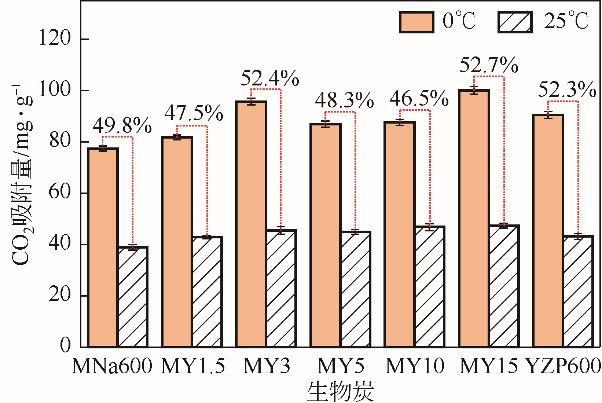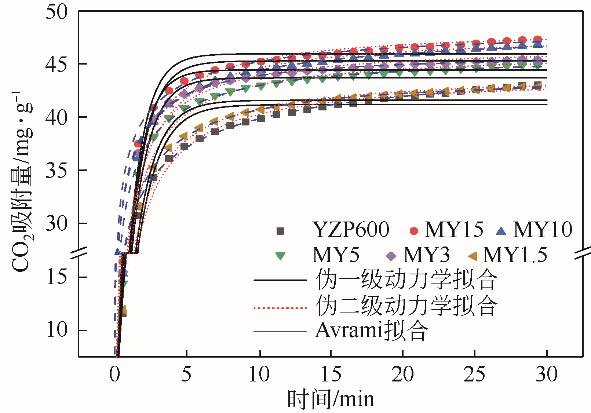Chemical Industry and Engineering Progress ›› 2023, Vol. 42 ›› Issue (S1): 356-363.DOI: 10.16085/j.issn.1000-6613.2023-0143
• Materials science and technology • Previous Articles Next Articles
Adsorption properties of CO2 on pomelo peel biochar impregnated by lignin
DAI Huantao( ), CAO Lingyu, YOU Xinxiu, XU Haoliang, WANG Tao, XIANG Wei, ZHANG Xueyang(
), CAO Lingyu, YOU Xinxiu, XU Haoliang, WANG Tao, XIANG Wei, ZHANG Xueyang( )
)
- School of Environmental Engineering, Xuzhou Institute of Technology, Xuzhou 221018, Jiangsu, China
-
Received:2023-02-06Revised:2023-03-20Online:2023-11-30Published:2023-10-25 -
Contact:ZHANG Xueyang
木质素浸渍柚子皮生物炭吸附CO2特性
戴欢涛( ), 曹苓玉, 游新秀, 徐浩亮, 汪涛, 项玮, 张学杨(
), 曹苓玉, 游新秀, 徐浩亮, 汪涛, 项玮, 张学杨( )
)
- 徐州工程学院环境工程学院,江苏 徐州 221018
-
通讯作者:张学杨 -
作者简介:戴欢涛(2002—),男,本科生,研究方向为生物炭及环境治理技术。E-mail:daihuanta@163.com。 -
基金资助:江苏省自然科学基金(BK20201151);徐州市科技计划(KC21288);江苏省高等学校自然科学研究重大项目(19KJA580002)
CLC Number:
Cite this article
DAI Huantao, CAO Lingyu, YOU Xinxiu, XU Haoliang, WANG Tao, XIANG Wei, ZHANG Xueyang. Adsorption properties of CO2 on pomelo peel biochar impregnated by lignin[J]. Chemical Industry and Engineering Progress, 2023, 42(S1): 356-363.
戴欢涛, 曹苓玉, 游新秀, 徐浩亮, 汪涛, 项玮, 张学杨. 木质素浸渍柚子皮生物炭吸附CO2特性[J]. 化工进展, 2023, 42(S1): 356-363.
share this article
Add to citation manager EndNote|Ris|BibTeX
URL: https://hgjz.cip.com.cn/EN/10.16085/j.issn.1000-6613.2023-0143
| 生物碳名称 | 比表面积/m2·g-1 | 总孔体积/cm3·g-1 | 微孔体积/cm3·g-1 | 平均孔径/nm | 灰分/% | 碱度/mmol·g-1 | 产率/% |
|---|---|---|---|---|---|---|---|
| MNa600 | 19.38 | 0.0503 | 0.0083 | 5.20 | 24.5 | 1.32 | 47.2 |
| MY1.5 | 13.11 | 0.0163 | 0.0054 | 2.48 | 12.6 | 0.74 | 79.6 |
| MY3 | 36.98 | 0.0462 | 0.0166 | 2.50 | 12.8 | 0.58 | 87.1 |
| MY5 | 35.17 | 0.0405 | 0.0159 | 2.30 | 5.1 | 0.61 | 89.5 |
| MY10 | 47.82 | 0.0409 | 0.0215 | 1.71 | 6.4 | 0.53 | 91.8 |
| MY15 | 51.15 | 0.0592 | 0.0207 | 2.31 | 8.4 | 0.56 | 91.8 |
| YZP600 | 13.95 | 0.0213 | 0.0025 | 3.06 | 5.6 | 0.45 | 28.1 |
| 生物碳名称 | 比表面积/m2·g-1 | 总孔体积/cm3·g-1 | 微孔体积/cm3·g-1 | 平均孔径/nm | 灰分/% | 碱度/mmol·g-1 | 产率/% |
|---|---|---|---|---|---|---|---|
| MNa600 | 19.38 | 0.0503 | 0.0083 | 5.20 | 24.5 | 1.32 | 47.2 |
| MY1.5 | 13.11 | 0.0163 | 0.0054 | 2.48 | 12.6 | 0.74 | 79.6 |
| MY3 | 36.98 | 0.0462 | 0.0166 | 2.50 | 12.8 | 0.58 | 87.1 |
| MY5 | 35.17 | 0.0405 | 0.0159 | 2.30 | 5.1 | 0.61 | 89.5 |
| MY10 | 47.82 | 0.0409 | 0.0215 | 1.71 | 6.4 | 0.53 | 91.8 |
| MY15 | 51.15 | 0.0592 | 0.0207 | 2.31 | 8.4 | 0.56 | 91.8 |
| YZP600 | 13.95 | 0.0213 | 0.0025 | 3.06 | 5.6 | 0.45 | 28.1 |
| 生物炭名称 | 伪一级动力学模型 | 伪二级动力学模型 | Avrami 模型 | 实验吸附量 /mg·g-1 | |||||||
|---|---|---|---|---|---|---|---|---|---|---|---|
| qe/mg·g-1 | k1/min-1 | R2 | qe/mg·g-1 | k2/g·mg-1·min-1 | R2 | qe/mg·g-1 | kA/min-1 | nA | R2 | ||
| MY1.5 | 41.59 | 0.7325 | 0.9492 | 44.14 | 0.0273 | 0.9561 | 41.77 | 0.7262 | 0.8697 | 0.9515 | 42.93 |
| MY3 | 44.44 | 0.9203 | 0.9520 | 46.68 | 0.0337 | 0.9283 | 44.32 | 0.9300 | 1.1780 | 0.9544 | 45.51 |
| MY5 | 43.70 | 0.8264 | 0.9510 | 46.12 | 0.0301 | 0.9453 | 43.72 | 0.8251 | 0.9788 | 0.9510 | 44.95 |
| MY10 | 45.28 | 0.8383 | 0.9433 | 47.80 | 0.0292 | 0.9450 | 45.34 | 0.8348 | 0.9503 | 0.9435 | 46.84 |
| MY15 | 45.95 | 0.8984 | 0.9479 | 48.35 | 0.0314 | 0.9351 | 45.88 | 0.9036 | 1.0890 | 0.9485 | 47.36 |
| YZP600 | 41.18 | 0.6874 | 0.9352 | 43.91 | 0.0251 | 0.9615 | 41.63 | 0.6720 | 0.7663 | 0.9438 | 43.15 |
| 生物炭名称 | 伪一级动力学模型 | 伪二级动力学模型 | Avrami 模型 | 实验吸附量 /mg·g-1 | |||||||
|---|---|---|---|---|---|---|---|---|---|---|---|
| qe/mg·g-1 | k1/min-1 | R2 | qe/mg·g-1 | k2/g·mg-1·min-1 | R2 | qe/mg·g-1 | kA/min-1 | nA | R2 | ||
| MY1.5 | 41.59 | 0.7325 | 0.9492 | 44.14 | 0.0273 | 0.9561 | 41.77 | 0.7262 | 0.8697 | 0.9515 | 42.93 |
| MY3 | 44.44 | 0.9203 | 0.9520 | 46.68 | 0.0337 | 0.9283 | 44.32 | 0.9300 | 1.1780 | 0.9544 | 45.51 |
| MY5 | 43.70 | 0.8264 | 0.9510 | 46.12 | 0.0301 | 0.9453 | 43.72 | 0.8251 | 0.9788 | 0.9510 | 44.95 |
| MY10 | 45.28 | 0.8383 | 0.9433 | 47.80 | 0.0292 | 0.9450 | 45.34 | 0.8348 | 0.9503 | 0.9435 | 46.84 |
| MY15 | 45.95 | 0.8984 | 0.9479 | 48.35 | 0.0314 | 0.9351 | 45.88 | 0.9036 | 1.0890 | 0.9485 | 47.36 |
| YZP600 | 41.18 | 0.6874 | 0.9352 | 43.91 | 0.0251 | 0.9615 | 41.63 | 0.6720 | 0.7663 | 0.9438 | 43.15 |
| 生物炭名称 | Langmuir模型 | Freundlich模型 | ||||
|---|---|---|---|---|---|---|
| qe/mg·g-1 | Kl/kPa-1 | R2 | n | Kf/mg·g-1·(kPa1/n )-1 | R2 | |
| MNa600 | 89.81 | 0.0468 | 0.9846 | 2.6319 | 13.53 | 0.9914 |
| MY1.5 | 92.33 | 0.0586 | 0.9894 | 2.7880 | 16.08 | 0.9829 |
| MY3 | 109.87 | 0.0503 | 0.9882 | 2.6406 | 16.98 | 0.9880 |
| MY5 | 97.69 | 0.0601 | 0.9901 | 2.8151 | 17.35 | 0.9815 |
| MY10 | 98.44 | 0.0609 | 0.9891 | 2.8220 | 17.61 | 0.9829 |
| MY15 | 114.66 | 0.0514 | 0.9873 | 2.6579 | 18.01 | 0.9885 |
| YZP600 | 99.67 | 0.0694 | 0.9859 | 3.0149 | 20.11 | 0.9806 |
| 生物炭名称 | Langmuir模型 | Freundlich模型 | ||||
|---|---|---|---|---|---|---|
| qe/mg·g-1 | Kl/kPa-1 | R2 | n | Kf/mg·g-1·(kPa1/n )-1 | R2 | |
| MNa600 | 89.81 | 0.0468 | 0.9846 | 2.6319 | 13.53 | 0.9914 |
| MY1.5 | 92.33 | 0.0586 | 0.9894 | 2.7880 | 16.08 | 0.9829 |
| MY3 | 109.87 | 0.0503 | 0.9882 | 2.6406 | 16.98 | 0.9880 |
| MY5 | 97.69 | 0.0601 | 0.9901 | 2.8151 | 17.35 | 0.9815 |
| MY10 | 98.44 | 0.0609 | 0.9891 | 2.8220 | 17.61 | 0.9829 |
| MY15 | 114.66 | 0.0514 | 0.9873 | 2.6579 | 18.01 | 0.9885 |
| YZP600 | 99.67 | 0.0694 | 0.9859 | 3.0149 | 20.11 | 0.9806 |
| 1 | 顾永正, 王天堃, 黄艳, 等. 燃煤电厂二氧化碳捕集利用与封存技术及工程应用[J]. 洁净煤技术, 2023, 29(4): 98-108. |
| GU Yongzheng, WANG Tiankun, HUANG Yan, et al. Carbon dioxide capture, utilization and storage technology and engineering application for coal-fired power plants[J]. Clean Coal Technology, 2023, 29(4): 98-108. | |
| 2 | 李艳玲, 卓振, 池亮, 等. 氮掺杂生物炭的制备与应用研究进展[J]. 化工进展, 2023, 42(7): 3720-3735. |
| LI Yanling, ZHUO Zhen, CHI Liang, et al. Research progress on preparation and application of nitrogen-doped biochar[J]. Chemical Industry and Engineering Progress, 2023, 42(7): 3720-3735. | |
| 3 | 盛奎川, 杨生茂. 生物炭概念的内涵及语词辨析[J]. 核农学报, 2022, 36(2): 481-487. |
| SHENG Kuichuan, YANG Shengmao. Biochar concept connotation and phrases discrimination[J]. Journal of Nuclear Agricultural Sciences, 2022, 36(2): 481-487. | |
| 4 | 林春岭, 钟来元, 钟晓岚, 等. 甘蔗渣生物炭吸附-还原Cr(Ⅵ)的反应研究[J]. 农业环境科学学报. [2023-03-30]. . |
| LIN Chuling, ZHONG Laiyuan, ZHONG Xiaolan, et al. Adsorption-reduction reaction between bagasse-prepared biochar and Cr(Ⅵ)[J]. Journal of Agro-Environment Science. [2023-03-30]. . | |
| 5 | 姜晶, 陈霄宇, 张瑞妍, 等. 载锰生物炭制备及其在环境修复中应用研究进展[J]. 化工进展, 2023, 42(8): 4385-4397. |
| JIANG Jing, CHEN Xiaoyu, ZHANG Ruiyan, et al. Research progress of manganese-loaded biochar preparation and its application in environmental remediation[J]. Chemical Industry and Engineering Progress, 2023, 42(8): 4385-4397. | |
| 6 | ZHANG Xueyang, GAO Bin, CREAMER Anne Elise, et al. Adsorption of VOCs onto engineered carbon materials: a review[J]. Journal of Hazardous Materials, 2017, 338: 102-123. |
| 7 | LENG Lijian, XU Siyu, LIU Renfeng, et al. Nitrogen containing functional groups of biochar: an overview[J]. Bioresource Technology, 2020, 298: 122286. |
| 8 | MA Changdan, BAI Jiali, DEMIR M, et al. Water chestnut shell-derived N/S-doped porous carbons and their applications in CO2 adsorption and supercapacitor[J]. Fuel, 2022, 326: 125-119. |
| 9 | KAYA Nihan, ZEYNEP Yıldız Uzun. Investigation of effectiveness of pine cone biochar activated with KOH for methyl orange adsorption and CO2 capture[J]. Biomass Conversion and Biorefinery, 2021, 11(3): 1067-1083. |
| 10 | DISSANAYAKE P D, CHOI S, IGALAVITHANA A, et al. Sustainable gasification biochar as a high efficiency adsorbent for CO2 capture: a facile method to designer biochar fabrication[J]. Renewable Sustainable Energy Reviews, 2020, 124: 109785. |
| 11 | ZHANG Xueyang, CAO Lingyu, XIANG Wei, et al. Preparation and evaluation of fine-tuned micropore biochar by lignin impregnation for CO2 and VOCs adsorption[J]. Separation and Purification Technology, 2022, 295: 121295. |
| 12 | CHOUDHURY Abhinav, LANSING Stephanie. Adsorption of hydrogen sulfide in biogas using a novel iron-impregnated biochar scrubbing system[J]. Journal of Environmental Chemical Engineering, 2021, 9(1): 104837. |
| 13 | ZHANG Han, LIAO Wei, ZHOU Xiaoming, et al. Coeffect of pyrolysis temperature and potassium phosphate impregnation on characteristics, stability, and adsorption mechanism of phosphorus-enriched biochar[J]. Bioresource Technology, 2022, 344: 126273. |
| 14 | BAILON Mark Xavier, CHAUDHARY Dhiraj Kumar, JEON Cheolho, et al. Impact of sulfur-impregnated biochar amendment on microbial communities and mercury methylation in contaminated sediment[J]. Journal of Hazardous Materials, 2022, 438: 129464. |
| 15 | BAJWA D S, POURHASHEM G, ULLAH A H, et al. A concise review of current lignin production, applications, products and their environmental impact[J]. Industrial Crops & Products, 2019, 139: 111526. |
| 16 | LUO Hao, ABU-OMAR Mahdi M. Chemicals from lignin[J]. Encyclopedia of sustainable technologies, 2017, 3: 573-585. |
| 17 | ZHANG Xueyang, MIAO Xudong, XIANG Wei, et al. Ball milling biochar with ammonia hydroxide or hydrogen peroxide enhances its adsorption of phenyl volatile organic compounds (VOCs)[J]. Journal of Hazardous Materials, 2021, 403: 123540. |
| 18 | CAO Lingyu, ZHANG Xueyang, XU Yue, et al. Straw and wood based biochar for CO2 capture: adsorption performance and governing mechanisms[J]. Separation Purification Technology, 2022, 287: 120-592. |
| 19 | SREEDHAR Subramanian, Øye GISLE. Aqueous carbon black dispersions stabilized by sodium lignosulfonates[J]. Colloid and Polymer Science, 2021, 299(7): 1-14. |
| 20 | CHEN Hong, ZHANG Yuting, LI Jialu, et al. Preparation of pickling-reheating activated alfalfa biochar with high adsorption efficiency for p-nitrophenol: characterization, adsorption behavior, and mechanism[J]. Environmental Science and Pollution Research, 2019, 26(15): 15300-15313. |
| 21 | MUSUMECI V, GORACCI G, SANZ CAMACHO P, et al. Correlation between the dynamics of nanoconfined water and the local chemical environment in calcium silicate hydrate nanominerals[J]. Chemistry–A European Journal, 2021, 27(44): 11309-11318. |
| 22 | ABDULKHANI Ali, AMIRI Elaheh, SHARIFZADEH Aghil, et al. Concurrent production of sodium lignosulfonate and ethanol from bagasse spent liquor[J]. Journal of Environmental Management, 2019, 231: 819-824. |
| 23 | XU Xiaoyun, ZHAO Yinghao, SIMA Jingke, et al. Indispensable role of biochar-inherent mineral constituents in its environmental applications: a review[J]. Bioresource Technology, 2017, 241: 887-899. |
| 24 | 杨萍, 梁文博, 李有喜, 等. CO2/N2在MOF-74(MgxZn1-x)上的吸附分离性能研究[J]. 当代化工, 2022, 51(8): 1822-1825, 1875. |
| YANG Ping, LIANG Wenbo, LI Youxi, et al. Adsorption and separation performance of CO2/N2 on MOF-74(MgxZn1-x)[J]. Contemporary Chemical Industry, 2022, 51(8): 1822-1825, 1875. | |
| 25 | 高飞, 王鹏, 单亚飞. 采空区遗煤吸附电厂烟气中CO2影响因素研究[J]. 煤炭科学技术: 1-10[2023-03-30]. . |
| GAO Fei, WANG Peng, SHAN Yafei. Study on influence factors of CO2 in flue gas of coal seam storage power plant in goaf area[J]. Coal Science and Technology: 1-10[2023-03-30]. . | |
| 26 | 刘清涛. PEI改性生物炭的制备及对CO2吸附性能的评价[J]. 环境科学学报, 2021, 41(3): 932-939. |
| LIU Qingtao. Preparation of PEI-modified biochar and evaluation of its CO2 adsorption performance[J]. Acta Scientiae Circumstantiae, 2021, 41(3): 932-939. | |
| 27 | 张涛, 王彬彬, 李瑶. 基于玉米秸秆的氮掺杂多孔碳制备及其对CO2吸附和CO2/N2分离性能研究[J]. 河南理工大学学报(自然科学版), 2022, 41(6): 174-180. |
| ZHANG Tao, WANG Binbin, LI Yao. Preparation of stalk-based nitrogen-doped porous carbon and its CO2 adsorption and CO2/N2 separation properties[J]. Journal of Henan Polytechnic University (Natural Science), 2022, 41(6): 174-180. | |
| 28 | FU Kun, LIU Chenxu, WANG Lemeng, et al. Performance and mechanism of CO2 absorption in 2-ethylhexan-1-amine + glyme non-aqueous solutions[J]. Energy, 2021, 220: 119735. |
| 29 | ALGHYAMAH Abdulaziz A, ELNOUR A, SHAIKH H, et al. Biochar/polypropylene composites: a study on the effect of pyrolysis temperature on crystallization kinetics, crystalline structure, and thermal stability[J]. Journal of King Saud University-Science, 2021, 33(4): 101409. |
| 30 | RAGANATI Federica, ALFE Michela, GARGIULO Valentina, et al. Kinetic study and breakthrough analysis of the hybrid physical/chemical CO2 adsorption/desorption behavior of a magnetite-based sorbent[J]. Chemical Engineering Journal, 2019, 372: 526-535. |
| 31 | ZHANG Xueyang, GAO Bin, ZHENG Yulin, et al. Biochar for volatile organic compound (VOC) removal: Sorption performance and governing mechanisms[J]. Bioresource Technology, 2017, 245: 606-614. |
| [1] | CHEN Chongming, CHEN Qiu, GONG Yunqian, CHE Kai, YU Jinxing, SUN Nannan. Research progresses on zeolite-based CO2 adsorbents [J]. Chemical Industry and Engineering Progress, 2023, 42(S1): 411-419. |
| [2] | WANG Shengyan, DENG Shuai, ZHAO Ruikai. Research progress on carbon dioxide capture technology based on electric swing adsorption [J]. Chemical Industry and Engineering Progress, 2023, 42(S1): 233-245. |
| [3] | YANG Ying, HOU Haojie, HUANG Rui, CUI Yu, WANG Bing, LIU Jian, BAO Weiren, CHANG Liping, WANG Jiancheng, HAN Lina. Coal tar phenol-based carbon nanosphere prepared by Stöber method for adsorption of CO2 [J]. Chemical Industry and Engineering Progress, 2023, 42(9): 5011-5018. |
| [4] | WANG Haoran, YIN Quanyu, FANG Ming, HOU Jianlin, LI Jun, HE Bin, ZHANG Mingyue. Optimization of near critical-water treatment process of tobacco stems [J]. Chemical Industry and Engineering Progress, 2023, 42(9): 5019-5027. |
| [5] | JIANG Jing, CHEN Xiaoyu, ZHANG Ruiyan, SHENG Guangyao. Research progress of manganese-loaded biochar preparation and its application in environmental remediation [J]. Chemical Industry and Engineering Progress, 2023, 42(8): 4385-4397. |
| [6] | GUAN Hongling, YANG Hui, JING Hongquan, LIU Yuqiong, GU Shouyu, WANG Haobin, HOU Cuihong. Lignin-based controlled release materials and application in drug delivery and fertilizer controlled-release [J]. Chemical Industry and Engineering Progress, 2023, 42(7): 3695-3707. |
| [7] | LI Yanling, ZHUO Zhen, CHI Liang, CHEN Xi, SUN Tanglei, LIU Peng, LEI Tingzhou. Research progress on preparation and application of nitrogen-doped biochar [J]. Chemical Industry and Engineering Progress, 2023, 42(7): 3720-3735. |
| [8] | BAI Yadi, DENG Shuai, ZHAO Ruikai, ZHAO Li, YANG Yingxia. Exploration on standardized test scheme and experimental performance of temperature swing adsorption carbon capture unit [J]. Chemical Industry and Engineering Progress, 2023, 42(7): 3834-3846. |
| [9] | REN Jianpeng, WU Caiwen, LIU Huijun, WU Wenjuan. Preparation of lignin-polyaniline composites and adsorption of Congo red [J]. Chemical Industry and Engineering Progress, 2023, 42(6): 3087-3096. |
| [10] | YU Dingyi, LI Yuanyuan, WANG Chenyu, JI Yongsheng. Preparation of lignin-based pH responsive hydrogel and its application in controlled drug release [J]. Chemical Industry and Engineering Progress, 2023, 42(6): 3138-3146. |
| [11] | LU Shijian, ZHANG Yuanyuan, WU Wenhua, YANG Fei, LIU Ling, KANG Guojun, LI Qingfang, CHEN Hongfu, WANG Ning, WANG Feng, ZHANG Juanjuan. Health risk assessment of nitrosamine pollutant diffusion in a million ton CO2 capture project [J]. Chemical Industry and Engineering Progress, 2023, 42(6): 3209-3216. |
| [12] | WANG Jiuheng, RONG Nai, LIU Kaiwei, HAN Long, SHUI Taotao, WU Yan, MU Zhengyong, LIAO Xuqing, MENG Wenjia. Enhanced CO2 capture performance and strength of cellulose-templated CaO-based pellets with steam reactivation [J]. Chemical Industry and Engineering Progress, 2023, 42(6): 3217-3225. |
| [13] | GU Shiya, DONG Yachao, LIU Linlin, ZHANG Lei, ZHUANG Yu, DU Jian. Design and optimization of pipeline system for carbon capture considering intermediate nodes [J]. Chemical Industry and Engineering Progress, 2023, 42(6): 2799-2808. |
| [14] | SANG Wei, TANG Jianfeng, HUA Yihuai, CHEN Jie, SUN Peiyuan, XU Yifei. Effects of physical solvent and amine properties on the performance of biphasic solvent [J]. Chemical Industry and Engineering Progress, 2023, 42(4): 2151-2159. |
| [15] | WANG Yu, YU Guangwei, JIANG Ruqing, LI Changjiang, LIN Jiajia, XING Zhenjiao. Adsorption of ciprofloxacin hydrochloride by biochar from food waste digestate residues [J]. Chemical Industry and Engineering Progress, 2023, 42(4): 2160-2170. |
| Viewed | ||||||
|
Full text |
|
|||||
|
Abstract |
|
|||||





